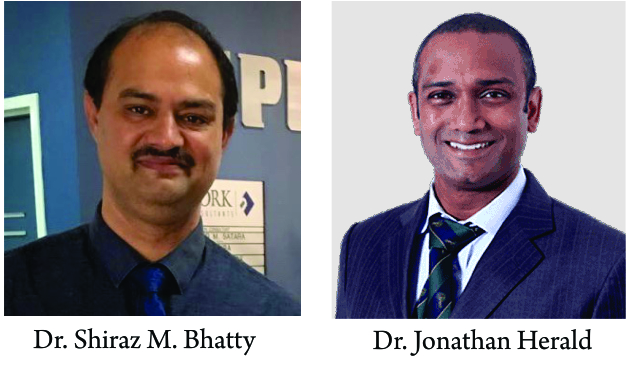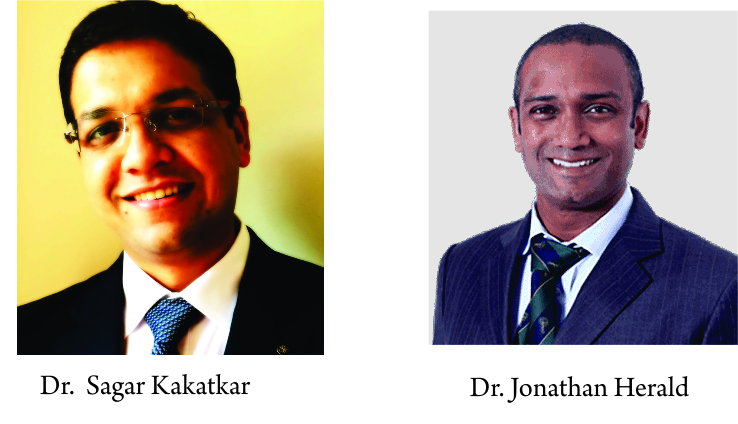Shiraz Michael Bhatty, Jonathan Herald
Volume 2 | Issue 1 | Jan – Apr 2017 | Page 29 -35
Author: Shiraz Michael Bhatty [1], Jonathan Herald [1].
[1] Fellow, Orthoclinic, Sydney
Address of Correspondence
Dr. Shiraz Michael Bhatty, Fellow, Orthoclinic, Sydney.
Email: shirazbhatty@gmail.com
Abstract
Traumatic anteroinferior dislocation of shoulder in young patients often results in recurrent instability and can be a challenging problem to solve surgically. Treatment of anterior shoulder instability continues to evolve. Arthroscopic shoulder stabilization has become a preferred method of treatment for shoulder instability because reported success rates are parallel to those of open stabilization techniques. This is due to continuing advancement in techniques, instrumentation, improved understanding of the associated pathoanatomy and proper patient selection. In addition to the typical capsulolabral disruptionsseen following a primary dislocation, patients with recurrent instability often have coexistent osseous injury to the humeral head and glenoid. Important considerations during arthroscopy include identifying all pathology, adequate mobilization of the capsulolabral sleeve, retensioning of glenohumeral sleeve and secure anatomic fixation. With advancements in technique and more accurate diagnoses, these outcomes will continue to rise, and patients will more reliably be able to return to prior functioning levels.
Keywords: disclocation of shoulder, pathoanatomy, capsulolabral sleeve.
References
1. Taverna E, Garavaglia G, Ufenast H, D’AmbrosiR, .Arthroscopic treatment of glenoid bone loss. Knee Surg Sports TraumatolArthrosc2016;24:546-556.
2. Lafosse L, Lejeune E, Bouchard A, Kakuda C, Gobezie R, Kochhar T. The arthroscopic Latarjet procedure for the treatment of anterior shoulder instability. Arthroscopy 2007;23:1242.e1-e5.
3. Fabbriciani C, Milano G, Demontis A, Fadda S, Ziranu F, Mulas PD. Arthroscopic versus open treatment of Bankart lesion of the shoulder: A prospective randomized study. Arthroscopy 2004;20:456-462.
4. Grossman MG, Tibone JE, McGarry MH, Schneider DJ, Veneziani S, Lee TQ. A cadaveric model of the throwing shoulder: A possible etiology of superior labrum anterior-to-posterior lesions. J Bone Joint Surg Am 2005;87:824-831.
5. Robinson CM, Dobson RJ. Anterior instability of the shoulder after trauma. J Bone Joint Surg Br 2004;86:469-479.
6. Van Thiel GS, Romeo AA, Provencher MT. Arthroscopic treatment of Antero-inferior shoulder instability. MinnervaOrthop E Traumatol 2010;61(5):393-414.
7. Cole BJ, Millett PJ, Romeo AA, Burkhart SS, Andrews JR, Dugas JR, et al. Arthroscopic treatment of anterior glenohumeral instability: Indications and techniques. Instr Course Lect2004;53:545-558.
8. Purchase RJ, Wolf EM, Hobgood ER, Pollock ME, Smalley CC. Hill-sachs “remplissage”: An arthroscopic solution for the engaging hill-sachs lesion. Arthroscopy 2008;24(6):723-726.
9. Turkel SJ, Panio MW, Marshall JL, Girgis FG. Stabilizing mechanisms preventing anterior dislocation of the glenohumeral joint. J Bone Joint Surg Am 1981;63:1208-1217.
10. Voos JE, Livermore RW, Feeley BT, Altchek DW, Williams RJ, Warren RF, et al. Prospective evaluation of arthroscopic Bankart repairs for anterior instability. Am J Sports Med 2010;38(2):302-307.
11. Warner JJ, McMahon PJ. The role of the long head of the biceps brachii in superior stability of the glenohumeral joint. J Bone Joint Surg Am 1995;77:366-372.
12. Burkart AC, Debski RE. Anatomy and function of the glenohumeral ligaments in anterior shoulder instability. ClinOrthopRelat Res 2002;32-39.
13. Dumont GD, Russell RD, Robertson WJ. Anterior shoulder instability: A review of pathoanatomy, diagnosis and treatment. Curr Rev Musculoskelet Med 2011;4(4):200-207.
14. Howell SM, Galinat BJ. The glenoid-labral socket. A constrained articular surface. ClinOrthopRelat Res 1989;122-125.
15. Ferrari DA. Capsular ligaments of the shoulder. Anatomical and functional study of the anterior superior capsule. Am J Sports Med 1990;18(1):20-24.
16. Matsen FA 3rd, Chebli C, Lippitt S; American Academy of Orthopaedic Surgeons. Principles for the evaluation and management of shoulder instability. J Bone Joint Surg Am 2006;88(3):648-659.
17. Murray IR, Ahmed I, White NJ, Robinson CM. Traumatic anterior shoulder instability in the athlete. Scand J Med Sci Sports 2013;23:387-405.
18. Provencher MT, Bhatia S, Ghodadra NS, Grumet RC, Bach BR Jr, Dewing CB, et al. Recurrent shoulder instability: Current concepts for evaluation and management of glenoid bone loss. J Bone Joint Surg Am 2010;92 Suppl 2:133-151.
19. Kim SH, Ha KI, Cho YB, Ryu BD, Oh I. Arthroscopic anterior stabilization of the shoulder: Two to six-year follow-up. J Bone Joint Surg Am 2003;85-A:1511-1518.
20. Castagna A, Garofalo R, Conti M, Flanagin B. Arthroscopic Bankart repair: Have we finally reached a gold standard? Knee Surg Sports TraumatolArthrosc2016;24:398-405.
21. Kim SJ, Kim SH, Park BK, Chun YM. Arthroscopic stabilization for recurrent shoulder instability with moderate glenoid bone defect in patients with moderate to low functional demand. Arthroscopy 2014;30:921-927.
22. Kinnard P, Tricoire JL, Levesque R, Bergeron D. Assessment of the unstable shoulder by computed arthrography. A preliminary report. Am J Sports Med 1983;11:157-159.
23. Neviaser TJ. The anterior labroligamentous periosteal sleeve avulsion lesion: A cause of anterior instability of the shoulder. Arthroscopy 1993;9(1):17-21.
24. Lafosse L, Boyle S, Gutierrez-Aramberri M, Shah A, Meller R. Arthroscopic latarjet procedure. OrthopClin North Am 2010;41:393-405.
25. Burkhart SS, De Beer JF. Traumatic glenohumeral bone defects and their relationship to failure of arthroscopic Bankart repairs: Significance of the inverted-pear glenoid and the humeral engaging Hill-Sachs lesion. Arthroscopy 2000;16(7):677-694.
26. HantesM and TsarouhasA (2011). Arthroscopic Treatment of Recurrent Anterior Glenohumeral Instability, Modern Arthroscopy, Dragoo JL (Ed.), InTech, DOI: 10.5772/28374. Available from: http://www.intechopen.com/books/modern-arthroscopy/arthroscopic-treatment-of-recurrent-anterior-glenohumeral-instability
27. Nebelung W, Jaeger A, Wiedemann E. Rationales of arthroscopic shoulder stabilization. Arch Orthop Trauma Surg 2002;122(8):472-487.
28. Rokous JR, Feagin JA, Abbott HG. Modified axillary roentgenogram. A useful adjunct in the diagnosis of recurrent instability of the shoulder. ClinOrthopRelat Res 1972;82:84-86.
29. Neviaser TJ. The GLAD lesion: Another cause of anterior shoulder pain. Arthroscopy 1993;9:22-23.
30. Torshizy H. MR Imaging of glenoid cartilage lesions. Applied Radiol. 2006;35:14-21.
31. Chandnani VP, Yeager TD, DeBerardino T et al. Glenoid labral tears: Prospective evaluation with MRI imaging, MR arthrography, and CT arthrography. AJR Am J Roentgenol 1993;161(6):1229-1235.
32. Oberlander MA, Morgan BE, Visotsky JL. The BHAGL lesion: A new variant of anterior shoulder instability. Arthroscopy 1996;12(5):627-633.
33. Abrams JS. Role of arthroscopy in treating anterior instability of the athlete’s shoulder. Sports Med Arthrosc 2007;15(4):230-238.
34. Boileau P, Villalba M, Héry JY, Balg F, Ahrens P, Neyton L. Risk factors for recurrence of shoulder instability after arthroscopic Bankart repair. J Bone Joint Surg Am 2006;88(8):1755-1763.
35. Zhu YM, Lu Y, Zhang J, Shen JW, Jiang CY Arthroscopic Bankart repair combined with remplissage technique for the treatment of anterior shoulder instability with engaging Hill-Sachs lesion: A report of 49 cases with a minimum 2-year follow-up. Am J Sports Med 2011;39(8):1640-1647.
36. Stein D, Laith M, Jazrawi ER, Loebenberg MI. Arthroscopic Stabilization of anterior shoulder instability a historical perspective. Bull Hosp Joint Dis 2001;60(3-4):124-129.
| How to Cite this article:. Bhatty SM, Herald J. Arthroscopic Stabilisation Techniques for Anterior Shoulder Instability. Asian Journal of Arthroscopy Jan – April 2017;1(2):29-35. |




